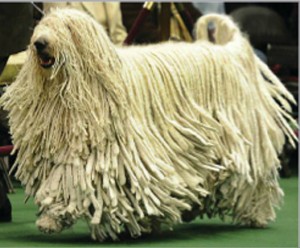Large Hungarian Sheepdogs – Komondor and Kuvasz
278 – June, 2016
By Ria Hörter
 Situated in the heart of Europe, Hungary (Magyar Köztársaság) is the country of pusztas (prairies) and the Danube, but also of Turkish occupation, Habsburg emperors, communist regimes and the 1956 uprising against the Russians. Until 1989, Hungary was a Socialist People’s Republic, but today it is an independent democratic republic.
Situated in the heart of Europe, Hungary (Magyar Köztársaság) is the country of pusztas (prairies) and the Danube, but also of Turkish occupation, Habsburg emperors, communist regimes and the 1956 uprising against the Russians. Until 1989, Hungary was a Socialist People’s Republic, but today it is an independent democratic republic.
For many ages, Hungary was a melting pot of Huns, Teutons, Slavs and Turks, among others. Between the fourth
and sixth century – known in Europe as the Great Migration – several local sheepdogs that would later became the national Hungarian breeds, had already been developed: the Puli, Pumi, Mudi (small sheepdogs) and the Komondor and Kuvasz (large sheepdogs). Today the pusztas are agricultural areas and the sheepdogs are all that’s left to remind us of the large flocks and their shepherds. Those shepherds didn’t know about genes or chromosomes, but they selected their dogs for working ability, strength, stamina and willingness to please. A good hunting dog or sheepdog had the same value as a cow or a sheep; an excellent sheepdog could be worth the annual income of a shepherd.
Komondor versus Kuvasz
The Komondor and Kuvasz are two separate breeds now, but in the 18th and 19th centuries their names were interchangeable. In some parts of Hungary where neither was known, people were unaware of the differences. Both were large, white, strong and courageous sheepdogs.
At that time, the Komondor was found mainly in the drier climate of Transylvania and present-day Slovakia; a wet climate does not suit the breed’s matted coat.
Once breeders and fanciers got involved with these dogs and official de- scriptions were published, the names Komondor and Kuvasz could no longer be used interchangeably.
Click here to read the complete article278 – June, 2016
Short URL: http://caninechronicle.com/?p=105650
Comments are closed











